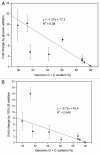Genetic bioaugmentation as an effective method for in situ bioremediation: functionality of catabolic plasmids following conjugal transfers
- PMID: 22705839
- PMCID: PMC3476876
- DOI: 10.4161/bioe.20551
Genetic bioaugmentation as an effective method for in situ bioremediation: functionality of catabolic plasmids following conjugal transfers
Abstract
Genetic bioaugmentation is an in situ bioremediation method that stimulates horizontal transfer of catabolic plasmids between exogenous donor cells and indigenous bacteria to increase the biodegradation potential of contaminants. A critical outcome of genetic bioaugmentation is the expression of an active catabolic phenotype upon plasmid conjugation. Using a pWW0-derivative TOL plasmid, we showed that certain genetic characteristics of the recipient bacteria, including genomic guanine-cytosine (G + C) content and phylogeny, may limit the expression of the transferred catabolic pathway. However, such genetic limitations observed in transconjugants could be overcome by the presence of an additional carbon source. Glucose and Luria-Bertani broth were shown to enhance the toluene degradation rates of transconjugants; these enhancement effects were dependent on transconjugant genomic G + C contents. Based on these observations, thorough genetic characterization of the indigenous microbial community in the contaminated environment of interest may provide a predictive tool for assessing the success of genetic bioaugmentation.
Figures




Comment in
- Ikuma K, Gunsch CK. Functionality of the TOL plasmid under varying environmental conditions following conjugal transfer. Appl Microbiol Biotechnol. 2012 doi: 10.1007/s00253-012-3949-8.
Similar articles
-
Properties affecting transfer and expression of degradative plasmids for the purpose of bioremediation.Biodegradation. 2021 Aug;32(4):361-375. doi: 10.1007/s10532-021-09950-1. Epub 2021 May 27. Biodegradation. 2021. PMID: 34046775 Free PMC article. Review.
-
Plasmid-Mediated Bioaugmentation for the Bioremediation of Contaminated Soils.Front Microbiol. 2017 Oct 9;8:1966. doi: 10.3389/fmicb.2017.01966. eCollection 2017. Front Microbiol. 2017. PMID: 29062312 Free PMC article. Review.
-
Functionality of the TOL plasmid under varying environmental conditions following conjugal transfer.Appl Microbiol Biotechnol. 2013 Jan;97(1):395-408. doi: 10.1007/s00253-012-3949-8. Epub 2012 Feb 26. Appl Microbiol Biotechnol. 2013. PMID: 22367613
-
Effect of carbon source addition on toluene biodegradation by an Escherichia coli DH5alpha transconjugant harboring the TOL plasmid.Biotechnol Bioeng. 2010 Oct 1;107(2):269-77. doi: 10.1002/bit.22808. Biotechnol Bioeng. 2010. PMID: 20506384
-
Impacts of gene bioaugmentation with pJP4-harboring bacteria of 2,4-D-contaminated soil slurry on the indigenous microbial community.Biodegradation. 2012 Apr;23(2):263-76. doi: 10.1007/s10532-011-9505-x. Epub 2011 Aug 18. Biodegradation. 2012. PMID: 21850504
Cited by
-
Properties affecting transfer and expression of degradative plasmids for the purpose of bioremediation.Biodegradation. 2021 Aug;32(4):361-375. doi: 10.1007/s10532-021-09950-1. Epub 2021 May 27. Biodegradation. 2021. PMID: 34046775 Free PMC article. Review.
-
Plasmid Backbone Impacts Conjugation Rate, Transconjugant Fitness, and Community Assembly of Genetically Bioaugmented Soil Microbes for PAH Bioremediation.ACS Environ Au. 2025 Jan 22;5(2):241-252. doi: 10.1021/acsenvironau.4c00123. eCollection 2025 Mar 19. ACS Environ Au. 2025. PMID: 40125281 Free PMC article.
-
Plasmid-Mediated Bioaugmentation for the Bioremediation of Contaminated Soils.Front Microbiol. 2017 Oct 9;8:1966. doi: 10.3389/fmicb.2017.01966. eCollection 2017. Front Microbiol. 2017. PMID: 29062312 Free PMC article. Review.
-
Enhanced plasmid-mediated bioaugmentation of RDX-contaminated matrices in column studies using donor strain Gordonia sp. KTR9.J Ind Microbiol Biotechnol. 2019 Oct;46(9-10):1273-1281. doi: 10.1007/s10295-019-02185-3. Epub 2019 May 22. J Ind Microbiol Biotechnol. 2019. PMID: 31119503
-
Examining horizontal gene transfer in microbial communities.Nat Rev Microbiol. 2021 Jul;19(7):442-453. doi: 10.1038/s41579-021-00534-7. Epub 2021 Apr 12. Nat Rev Microbiol. 2021. PMID: 33846600 Review.
References
Publication types
MeSH terms
Substances
LinkOut - more resources
Full Text Sources
